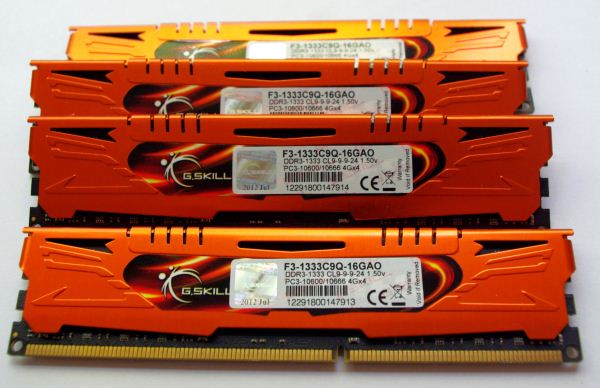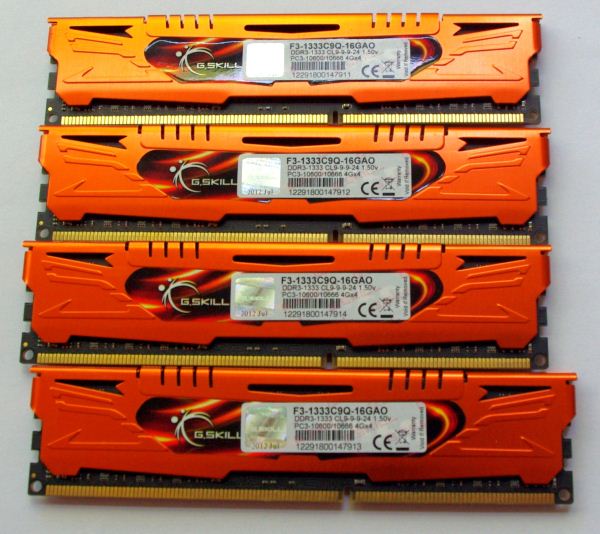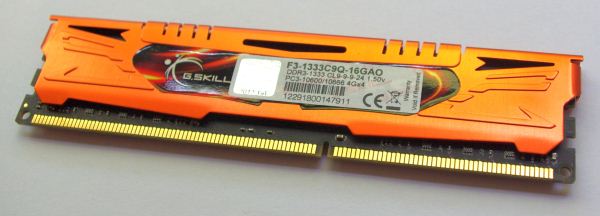Memory Performance: 16GB DDR3-1333 to DDR3-2400 on Ivy Bridge IGP with G.Skill
by Ian Cutress on October 18, 2012 12:00 PM EST- Posted in
- Memory
- G.Skill
- Ivy Bridge
- DDR3
At the lowest end of our testing, we have a 16GB DDR3-1333 9-9-9 kit on hand. When DDR3 was first released, the main speed available was DDR3-800, but enough time has passed that this has phased out and now 1333 MHz is the new ‘minimum’. With the prices of memory as they are, this kit from G.Skill currently retails for $75, meaning that a massive amount of memory is available for all at a reasonable level. To put this into contrast, I remember spending ~$240 on a 2x2 GB Kit of DDR2-800 5-5-5 about 5-6 years ago – we can now get four times the capacity for less than a third of the price.
DDR3-1333 sits at the bottom end, but within months we can imagine DDR3-1600 taking that spot – as we will see with the next kit, for $5 more we get a faster product.
Visual Inspection
Our first kit features G.Skill’s Ares branding – the Ares kits that G.Skill sell are essentially meant to be the lower profile but colored heatsinks. These heatsinks in all honesty may not be entirely necessary for cooling, but they are firmly bonded to the memory modules and removing them would be a large task and more than likely damage the module. I have seen horror stories of chips being removed along with the heatsink, making the memory unusable. As a result we cannot directly observe which ICs are being used in our kits for this review. A quick word in the ear of G.Skill and they will not tell us the information, under the guise that it is classified and if the competition wants to know what G.Skill are using, they will have to buy a kit and break it themselves. Given how small the margins are in memory sales (as well as potential market stagnation after the credit crisis), I’m not surprised with the level of secrecy.
Anyway, back to the kit:
The standard packaging at G.Skill is a rather efficient plastic container holding each of the modules. The packaging is easy enough to open, though I also found it fairly brittle, meaning small shards could break off and be easily lodged in feet. Inside the box itself is a piece of card to advertise the kit and protect the modules from each other. We also get a small G.Skill sticker for the computer case.
JEDEC + XMP Settings
| G.Skill | |||||
| Kit Speed | 1333 | 1600 | 1866 | 2133 | 2400 |
| Subtimings | 9-9-9-24 2T | 9-9-9-24 2T | 9-10-9-28 2T | 9-11-10-28 2T | 10-12-12-31 2T |
| Price | $75 | $80 | $95 | $130 | $145 |
| XMP | No | Yes | Yes | Yes | Yes |
| Size | 4 x 4 GB | 4 x 4 GB | 4 x 4 GB | 4 x 4 GB | 4 x 4 GB |
|
|
|||||
| MHz | 1333 | 1600 | 1867 | 2134 | 2401 |
| Voltage | 1.500 | 1.500 | 1.500 | 1.650 | 1.650 |
| tCL | 9 | 9 | 9 | 9 | 10 |
| tRCD | 9 | 9 | 10 | 11 | 12 |
| tRP | 9 | 9 | 9 | 10 | 12 |
| tRAS | 24 | 24 | 28 | 28 | 31 |
| tRC | 33 | 33 | 37 | 38 | 43 |
| tWR | 10 | 12 | 14 | 16 | 16 |
| tRRD | 4 | 5 | 5 | 6 | 7/6 |
| tRFC | 107 | 128 | 150 | 171 | 313 |
| tWTR | 5 | 6 | 8/7 | 9/8 | 10/9 |
| tRTP | 5 | 6 | 8/7 | 9/8 | 10/9 |
| tFAW | 20 | 24 | 24 | 25 | 26 |
| tCWL | - | 7 | 7 | 7 | 7 |
| CR | - | 2 | 2 | 2 | 2 |






















114 Comments
View All Comments
ssj4Gogeta - Thursday, October 18, 2012 - link
"Besides, do people really play games with IGP?"They're definitely more likely to play games on a more powerful IGP like AMD's. I thought the whole point of AMD's Fusion lineup was that you could do light gaming on the IGP itself.
SeanJ76 - Saturday, June 21, 2014 - link
Exactly! no one buys shitty AMD products anymore......Boogaloo - Thursday, October 18, 2012 - link
There are already plenty of benchmarks out there for memory scaling on AMD's APUs. This is the first time I've seen an in-depth look at how memory speed affects Intel's IGP performance.ssj4Gogeta - Thursday, October 18, 2012 - link
That's what I was thinking as well.I'm hoping for another article using Trinity. :)
Calin - Friday, October 19, 2012 - link
I'm not sure A10 supports DDR3-2400 (DDR3-1866 was the fastest memory supported)Medallish - Friday, October 19, 2012 - link
The A10 has AMP profiles(Like XMP on Intel) up to 2133MHz, however, there's always overclocking, I'm pretty sure Ivy Bridge doesn't suppoort 2400+MHz memory natively either. I'm looking at an FM2 board by Asrock which they claim can support 2600MHz memory.IanCutress - Friday, October 19, 2012 - link
My A10-5800K sort of liked DDR3-2400, then it didn't like it. Had to go back one to 2133 for the testing. Even with bumped voltages and everything else, the CPU memory controller couldn't take it. Perhaps the sample I have is a dud, but that was my experience.Ian
tim851 - Friday, October 19, 2012 - link
I concur.Pointless review anyway. The summary should have read: High-Clocked Memory only needed if your primary usage is either competitive benchmarking or WinRAR compression.
IanCutress - Saturday, October 20, 2012 - link
Did you know that before you read the article though? This is Anandtech, and I like to think I test things thoroughly enough to make reasoned opinions and suggestions :) Having a one sentence summary wouldn't have helped anyone in the slightest.Ian
SeanJ76 - Saturday, June 21, 2014 - link
Nothing is better done on AMD products idiot.....